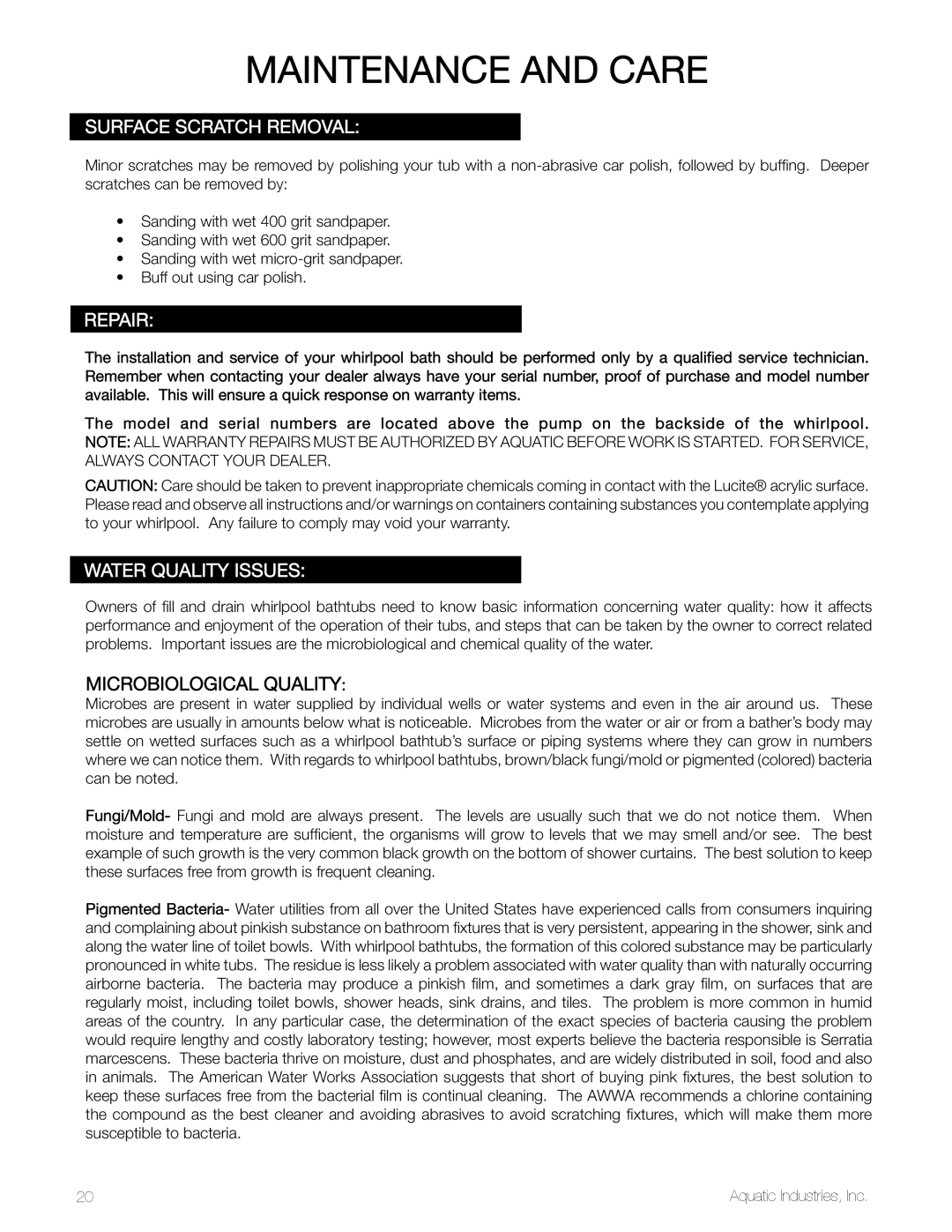
MAINTENANCE
 and care
and care

SURFACE
 SCRATCH
SCRATCH
 REMOVAL:
REMOVAL:
Minor scratches may be removed by polishing your tub with a
•Sanding with wet 400 grit sandpaper.
•Sanding with wet 600 grit sandpaper.
•Sanding with wet
•Buff out using car polish.
repair:
The installation![]()
![]() and service of your whirlpool
and service of your whirlpool![]()
![]() bath should be performed only by a qualified service technician. Remember when contacting your dealer always have your serial
bath should be performed only by a qualified service technician. Remember when contacting your dealer always have your serial![]()
![]() number, proof of purchase and model
number, proof of purchase and model![]()
![]() number available. This will
number available. This will![]()
![]() ensure a quick response on warranty items.
ensure a quick response on warranty items.![]()
![]()
![]()
The model![]()
![]() and serial
and serial![]()
![]() numbers are located
numbers are located![]()
![]() above the pump on the backside of the whirlpool. note:
above the pump on the backside of the whirlpool. note:![]()
![]()
![]() all warranty repairs must be authorized by aquatic before work is started. for service, always contact your dealer.
all warranty repairs must be authorized by aquatic before work is started. for service, always contact your dealer.
caution:![]()
![]() Care should be taken to prevent inappropriate chemicals coming in contact with the Lucite® acrylic surface. Please read and observe all instructions and/or warnings on containers containing substances you contemplate applying to your whirlpool. Any failure to comply may void your warranty.
Care should be taken to prevent inappropriate chemicals coming in contact with the Lucite® acrylic surface. Please read and observe all instructions and/or warnings on containers containing substances you contemplate applying to your whirlpool. Any failure to comply may void your warranty.
water quality issues:

Owners of fill and drain whirlpool bathtubs need to know basic information concerning water quality: how it affects performance and enjoyment of the operation of their tubs, and steps that can be taken by the owner to correct related problems. Important issues are the microbiological and chemical quality of the water.
Microbiological Quality:

Microbes are present in water supplied by individual wells or water systems and even in the air around us. These microbes are usually in amounts below what is noticeable. Microbes from the water or air or from a bather’s body may settle on wetted surfaces such as a whirlpool bathtub’s surface or piping systems where they can grow in numbers where we can notice them. With regards to whirlpool bathtubs, brown/black fungi/mold or pigmented (colored) bacteria can be noted.
Fungi/Mold![]()
![]() - Fungi and mold are always present. The levels are usually such that we do not notice them. When moisture and temperature are sufficient, the organisms will grow to levels that we may smell and/or see. The best example of such growth is the very common black growth on the bottom of shower curtains. The best solution to keep these surfaces free from growth is frequent cleaning.
- Fungi and mold are always present. The levels are usually such that we do not notice them. When moisture and temperature are sufficient, the organisms will grow to levels that we may smell and/or see. The best example of such growth is the very common black growth on the bottom of shower curtains. The best solution to keep these surfaces free from growth is frequent cleaning.
Pigmented Bacteria- Water utilities from all over the United States have experienced calls from consumers inquiring and complaining about pinkish substance on bathroom fixtures that is very persistent, appearing in the shower, sink and along the water line of toilet bowls. With whirlpool bathtubs, the formation of this colored substance may be particularly pronounced in white tubs. The residue is less likely a problem associated with water quality than with naturally occurring airborne bacteria. The bacteria may produce a pinkish film, and sometimes a dark gray film, on surfaces that are regularly moist, including toilet bowls, shower heads, sink drains, and tiles. The problem is more common in humid areas of the country. In any particular case, the determination of the exact species of bacteria causing the problem would require lengthy and costly laboratory testing; however, most experts believe the bacteria responsible is Serratia marcescens. These bacteria thrive on moisture, dust and phosphates, and are widely distributed in soil, food and also in animals. The American Water Works Association suggests that short of buying pink fixtures, the best solution to keep these surfaces free from the bacterial film is continual cleaning. The AWWA recommends a chlorine containing the compound as the best cleaner and avoiding abrasives to avoid scratching fixtures, which will make them more susceptible to bacteria.
20 | Aquatic Industries, Inc. |
